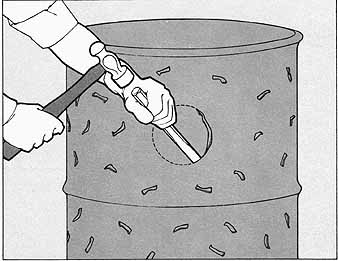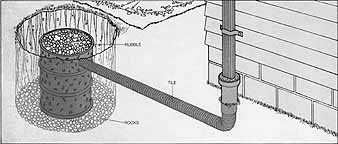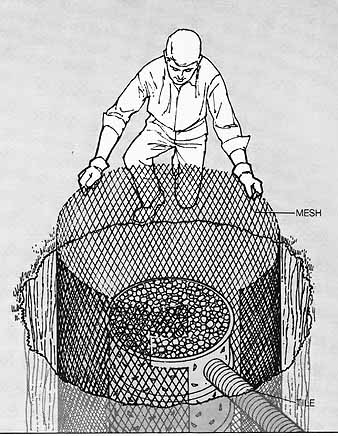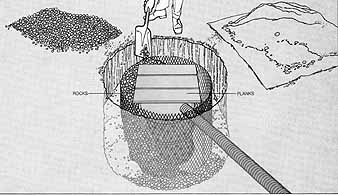In densely populated areas where town ordinances often forbid draining rain water into the street or sewer, another method for dispersing runoff is through a dry well—a pit that collects water and lets it slowly percolate into the soil. How ever, in some localities even dry wells are prohibited, because they may disturb nearby septic tanks. Before building one, check the local health department rules or building codes.
Some dry wells are huge, cement-lined bunkers best left for a contractor to build. But a do-it-yourself type can easily be made from a standard 55-gallon oil drum available from service stations or farm- supply outlets at a nominal cost. Prepare the drum by removing top and bottom and cutting a hole in its side with a cold chisel as shown at right. Then choose a place for the well at least 10 feet from the downspout and along the track of the underground drain tile that will connect to the drum.
Excavating a hole 5 feet deep may be difficult in rocky soil. If a pick or breaker bar are not adequate for breaking large rocks in the hole, rent a jackhammer.

1. Cutting the drum. Use
a ¾-inch cold chisel to remove the top and bottom of the drum and to carve
a hole in its side large enough to admit drain tile that's 4 inches in
diameter. First knock the chisel through the metal with a ball-peen hammer.
Then use the carving edge of the chisel to slice sideways through the drum.
Wear gloves and always cut from the outside of the drum. After cutting
the tile hole, use a chisel and hammer to punch about 25 small drain holes
spaced uniformly all around the drum.

2. Placing the drum. Remove and save the sod from an area 6 feet in diameter. Dig the hole to a 5-foot
depth. Line the bottom with 2 to 4 inches of small rocks, and sink the
barrel into place. Connect the underground drain tile to the drum through
the hole. (The method for installing tile is shown on) Fill the drum With
miscellaneous masonry rubble or large rocks.

3. Wrapping with mesh. Use
a 10-foot-long, 4-foot- wide section of 1/4-inch wire mesh to circle the
drum. Using tin snips, cut a 4-inch-wide opening 6 inches into one end
of the mesh at the level that the tile enters the drum. At the other end
of the mesh, twist on several short pieces of scrap wire for holding the
ends of the mesh together. Slide the mesh around the drum, fitting the
opening around the tile, overlapping the ends and tying them together with
the pieces of short wire.

4. Filling the well. Cover
the top of the drum with 1/4-inch wire mesh and sturdy planks to prevent
earth or surface water from entering. Fill the hole, alternately putting
small rocks between the mesh and drum, and soil between the mesh and the
sides of the well. Filling the gravel first would cause the mesh to open.
Cover the drum with at least 1 foot of soil and replace the sod.